Luxury Car Brands: Ferrari - The Ultimate Symbol of Speed and Luxury
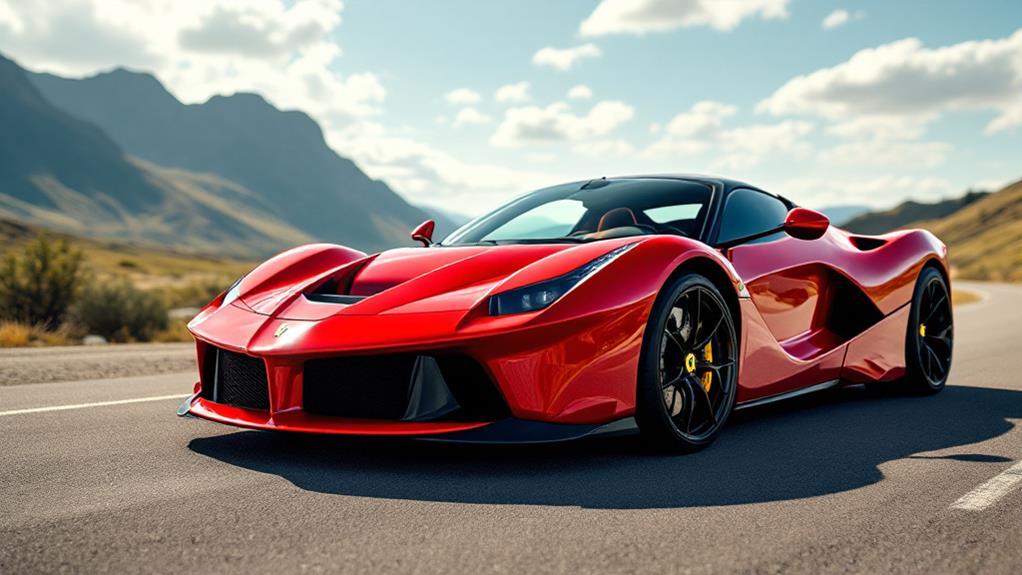
When you think of speed and luxury, Ferrari instantly comes to mind. Founded by Enzo Ferrari in 1939, it's not just a car brand; it's a statement. Models like the Ferrari 250 GTO and F40 aren't just vehicles but masterpieces combining unparalleled performance with the sleekest aerodynamic designs. With its roaring engines and innovations in lightweight construction, every Ferrari promises thrill and prestige. The brand's success in Formula One racing only cements its reputation. Limited edition models further amplify its exclusivity, making them prized collectibles. Start exploring how Ferrari continues to lead in innovation and luxury.
Historical Significance of Ferrari
Ferrari's historical significance is rooted in its origins, founded by Enzo Ferrari in 1939 with a keen focus on racing. This dedication laid the foundation for a rich racing heritage that continues to define the brand. As you investigate Ferrari's expedition, you'll see how its commitment to innovation and performance has cemented its status as a luxury car icon. The prancing horse logo, synonymous with speed and luxury, represents Ferrari's unwavering pursuit of excellence.
When you think about Ferrari's innovation, the 125 S, launched in 1947, stands out. With its 1.5 L V12 engine, this car set the stage for the brand's future successes. Ferrari's reputation for limited production amplifies its allure, making models like the Ferrari 250 GTO highly coveted. With only 36 units produced, it epitomizes exclusivity and remains a prized collector's item.
Ferrari's historical significance isn't just about cars; it's about the legacy of Enzo Ferrari's vision and the brand's impact on automotive history. Each vehicle tells a story of luxury, performance, and a racing spirit that continues to inspire car enthusiasts around the world.
Iconic Design and Aerodynamics
As you investigate Ferrari's odyssey from a racing powerhouse to a luxury car icon, you'll uncover that its commitment to performance extends beyond the engine to the very shape of its vehicles. The Ferrari F40 is a prime example of how iconic design and aerodynamics merge to create an unparalleled driving experience. Every curve and angle of the F40 is painstakingly crafted to improve performance.
- Aerodynamic Sculpting: The F40's sharp lines and aggressive angles are a demonstration of Ferrari's dedication to aerodynamic efficiency, ensuring stability at high speeds.
- Advanced Materials: Carbon fiber and Kevlar play critical roles in reducing weight and enhancing the car's aerodynamic capabilities, showcasing Ferrari's engineering excellence.
- Wind Tunnel Testing: Extensive testing optimized the exterior elements, reducing drag and increasing downforce, which are vital for high-speed performance.
- Functional Design Elements: The prominent rear wing and large air intakes aren't just for show; they provide fundamental airflow for cooling and stability.
Ferrari's design philosophy intricately weaves racing experience with groundbreaking engineering, resulting in cars that are not only luxurious but also exemplars of performance and functionality. The F40 remains a benchmark in the domain of luxury cars, where form perfectly complements function.
Engine and Performance Mastery
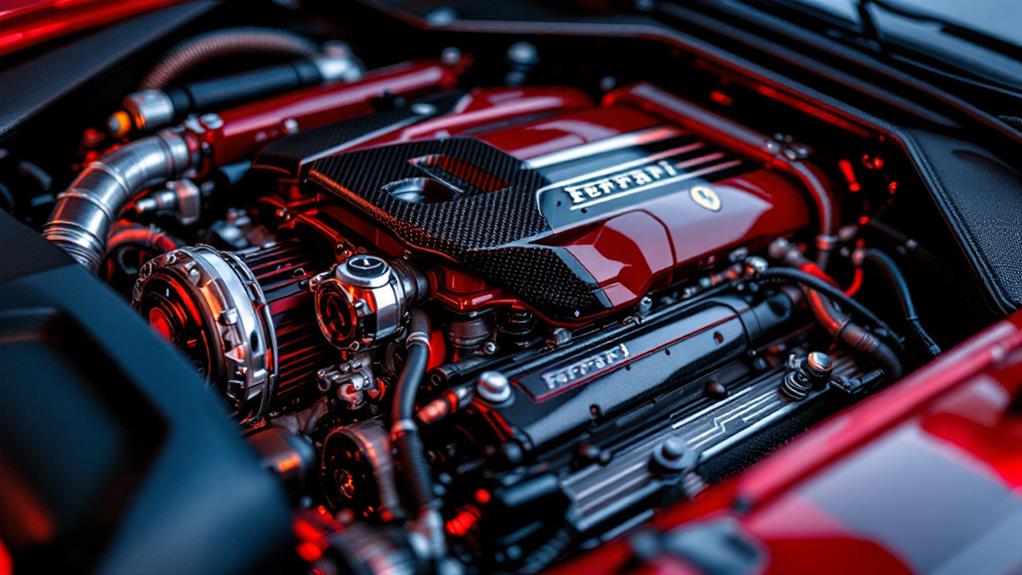
The heart of a Ferrari, like the legendary F40, isn't just an engine—it's a masterpiece of engineering and performance mastery. When you get behind the wheel of this high-performance sports car, you're experiencing the power of a 2.9-liter twin-turbocharged V8 engine that produces an awe-inspiring 478 horsepower and 426 lb-ft of torque. This kind of power output wasn't just revolutionary for its time; it set a new standard for what high-performance sports cars could achieve.
Ferrari's commitment to lightweight construction plays an essential role in this performance. By employing advanced materials like carbon fiber and Kevlar, Ferrari guarantees that their cars not only accelerate faster but also handle with precision. This precision-tuned handling, coupled with aerodynamic efficiency, provides exceptional responsiveness and agility. You'll feel the thrilling performance both on the open road and the track, showcasing Ferrari's engine and performance mastery.
Moreover, the distinctive exhaust note of Ferrari engines, especially in models like the F40, adds a unique emotional connection. It's not just about speed; it's about the symphony of engineering that makes driving a Ferrari an unforgettable experience.
Lightweight Construction Techniques
How do Ferrari's lightweight construction techniques transform their cars into icons of speed and precision? It all starts with the use of advanced materials like carbon fiber and Kevlar. By integrating these materials, Ferrari achieves a significant weight reduction without compromising structural integrity or performance. This is an indication of Ferrari's commitment to delivering exceptional driving dynamics in every model.
- Carbon Fiber Mastery: Ferrari's extensive use of carbon fiber not only reduces weight but also improves acceleration and handling. This results in a power-to-weight ratio that sets industry standards, making their supercars agile and responsive.
- Aerodynamic Efficiency: Every Ferrari is designed with aerodynamic efficiency in mind. Extensive wind tunnel testing guarantees that each element contributes to performance while keeping weight to a minimum.
- Raw Driving Experience: Some Ferrari models forego electronic aids to emphasize the raw nature of driving. This approach, coupled with lightweight construction techniques, requires skill and precision, showcasing Ferrari's dedication to speed.
- Commitment to Innovation: By focusing on cutting-edge materials and techniques, Ferrari continuously pushes the boundaries of what's possible in automotive design, reinforcing its status as a leader in speed and luxury.
Cultural Impact and Collectibility
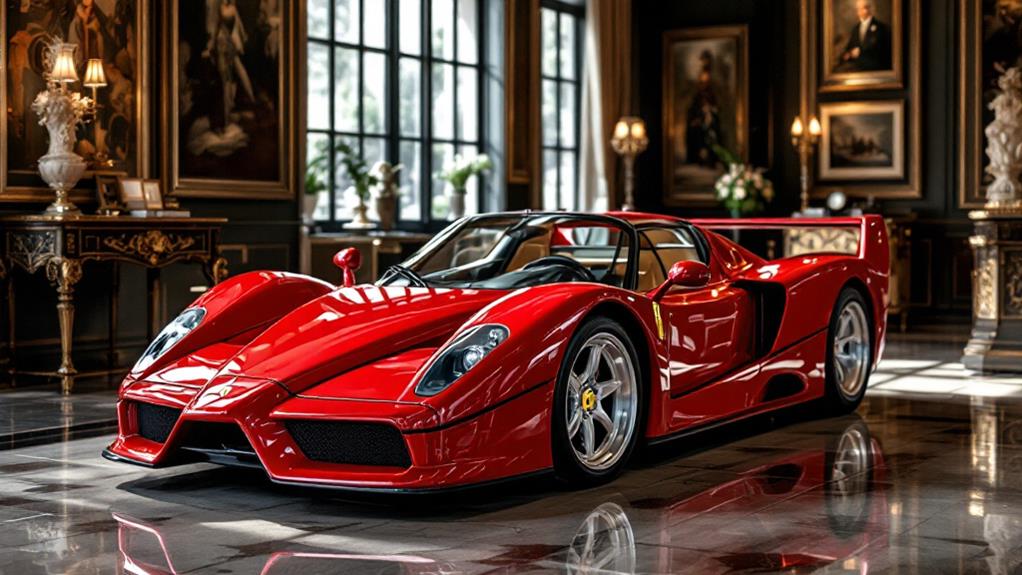
Ferrari isn't just about speed; it's a symbol of luxury and exclusivity that echoes worldwide. Ferrari cars have achieved legendary status, becoming cultural icons that transcend the automotive world. Iconic models like the Ferrari 250 GTO and F40 are more than just vehicles; they're pieces of automotive art, celebrated for their careful craftsmanship and attention to detail. These cars are highly sought-after, with their exclusivity and desirability making them prime targets for collectors.
The cultural significance of Ferrari is evident in the astronomical prices their cars command at auctions. The 250 GTO, for example, set a record by selling for $70 million in 2018. Such figures underscore the high value placed on well-preserved, rare models. Limited production runs, like the F40 with only 1,315 units and the 250 GTO with just 36, further amplify their allure and legendary status.
Ferrari's impact isn't limited to collectors; it spans a global enthusiast community. Events like the annual Ferrari Cavalcade bring together fans and collectors, fostering a shared passion for these extraordinary vehicles. In the world of luxury cars, Ferrari stands as a reflection of cultural influence and timeless collectibility.
Racing Heritage and Achievements
Rarely does a brand dominate the racing world as thoroughly as Scuderia Ferrari. Founded by Enzo Ferrari in the early 1930s, it's the most successful team in Formula One history. With over 15 drivers' titles and 16 constructors' championships, Ferrari's commitment to racing excellence is unmatched. This storied history includes legendary drivers like Michael Schumacher and Niki Lauda, who have greatly shaped the team's legacy. As you investigate Ferrari's racing heritage, you'll notice a few key elements that set them apart:
- Performance: The knowledge gained from racing has been directly applied to improve the performance of Ferraris, guaranteeing they're not just luxury cars but the ultimate driving machines.
- Technological Advancements: Innovations in aerodynamics and engine design, stemming from their racing endeavors, showcase their attention to detail.
- Mid-Engine Layout: Models like the Ferrari 488 GTB highlight the fusion of power and precision, reflective of their racing heritage.
- Storied History: Their long-standing success and the influence of iconic drivers continue to raise Ferrari's reputation.
Ferrari's blend of luxury and racing prowess guarantees that you're not just driving a car but experiencing a legacy of excellence.
Innovations in Technology
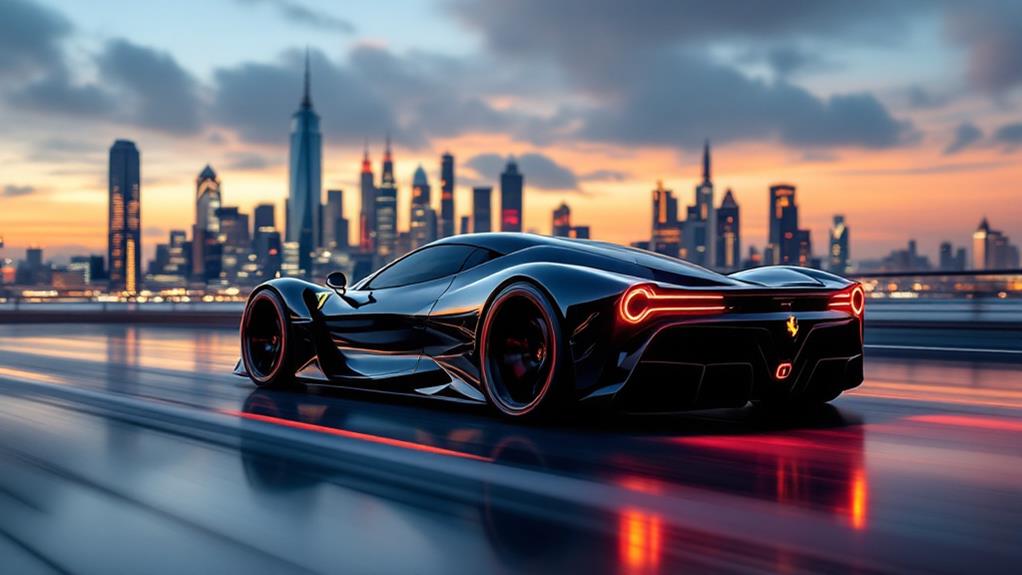
While Ferrari's racing heritage sets a foundation of performance and prestige, their relentless pursuit of innovation in technology propels them forward. Ferrari's commitment to advancing automotive technology is evident in their development of lightweight materials like carbon fiber and Kevlar, which drastically reduce a car's weight and elevate performance. These innovations in technology guarantee that every Ferrari is a high-performance vehicle, carefully crafted for speed and agility.
The introduction of hybrid hypercars like the LaFerrari showcases Ferrari's dedication to blending power with efficiency. By combining a V12 engine with an electric motor, the LaFerrari delivers an impressive 950 horsepower. This isn't just about raw power; it's about maintaining efficiency without compromising on performance. The SF90 Stradale further emphasizes Ferrari's commitment to sustainability with its status as the brand's initial plug-in hybrid. It combines a powerful engine with an electric-only range, highlighting the future of high-performance vehicles.
Ferrari's powerful engines, such as the twin-turbo V8 in the F40, are indicative of their continuous innovation. Their advancements in aerodynamics, refined through rigorous wind tunnel testing, improve stability and handling, underscoring Ferrari's dedication to cutting-edge automotive technology.
Exclusive Limited Edition Models
Celebrating exclusivity and craftsmanship, Ferrari's limited edition models capture the essence of luxury and prestige in the automotive world. Each model is a masterpiece, embodying the brand's commitment to innovation and its symbol of speed. Every Ferrari with its iconic prancing horse logo is crafted to captivate enthusiasts and maintain an enduring appeal among collectors.
- Ferrari 250 GTO (1962-1964): Only 36 units were produced, making it one of the most coveted luxury sports cars. Auction prices have soared to $70 million, highlighting its rarity and desirability.
- Ferrari F40 (1987): Introduced for Ferrari's 40th anniversary, this model features a lightweight construction and a twin-turbocharged V8. With 1,315 units made, it set new standards for supercars of its time.
- Ferrari Enzo (2002): Limited to 400 units, the Enzo incorporated advanced Formula 1 technology, marking a milestone in Ferrari's evolution as a hypercar manufacturer.
- LaFerrari (2013): As Ferrari's initial hybrid model, it combines a 6.3-liter V12 engine with an electric motor. Only 499 units were made, setting new benchmarks for performance in luxury automobiles.
These exclusive limited edition models reflect Ferrari's unmatched dedication to excellence.
Sustainability and Future Vision
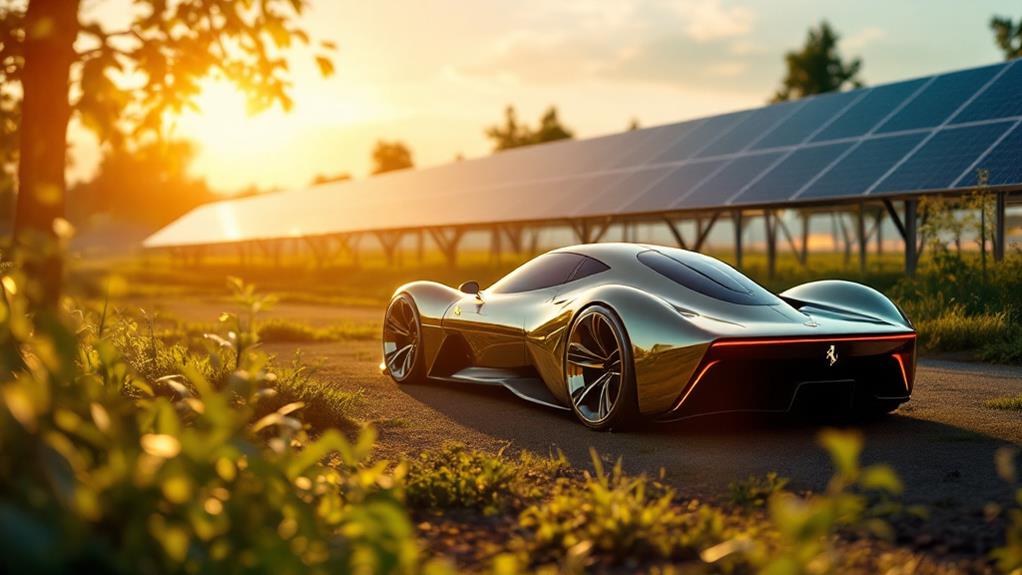
Ferrari's dedication to exclusivity and craftsmanship doesn't stop at limited edition masterpieces; it extends into their vision for sustainability and the future. Every step Ferrari takes reflects their commitment to environmental responsibility without compromising luxury and speed. By 2025, Ferrari aims to electrify 60% of its lineup, showcasing their dedication to sustainability while maintaining the high-performance standards you expect from the iconic Ferrari brand.
The SF90 Stradale, Ferrari's initial plug-in hybrid, is a proof of their groundbreaking approach. With 986 horsepower and the ability to travel 16 miles on electric power alone, it exemplifies Ferrari's successful integration of hybrid technology. This model isn't just about reducing emissions; it's about maintaining the thrilling performance synonymous with Ferrari. Similarly, the LaFerrari, their premier hybrid model, combines a 6.3-liter V12 engine with an electric motor, producing 950 horsepower, illustrating the seamless blend of performance and sustainability.
Ferrari's participation in the EU Green Deal and their aim for carbon neutrality by 2050 highlight a future vision rooted in environmental responsibility. Models like the Purosangue SUV demonstrate Ferrari's ability to adapt to market trends while remaining true to their legacy of luxury and speed.




